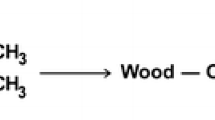Summary
The penetration characteristics of five modern wood coatings (three waterborne, one high solid and one solvent borne) into pine sapwood, spruce and dark red meranti have been systematically compared. The degree of coating penetration is mainly determined by the ability of the coating to flow into wood capillaries. Binder type, pigmentation, solid matter content and drying speed appeared to influence this ability. In softwoods the following different coating penetration routes are observed: the flow into open ends of longitudinal early-and latewood tracheids, the flow into ray cells and the transport from rays through the cross-field into longitudinal tracheids adjacent to rays. The possibility for the coating to follow the latter route is strongly influenced by the existing type of cross field pitting and to a lesser degree by the pigmentation of the paint. Clear differences between pine and spruce have been found with respect to the flow into ray parenchym and ray tracheids. The flow into open ends of longitudinal tracheids is strongly influenced by the grain angle of tracheids. Penetration into dark red meranti is mainly limited to vessels and rays. Tylose membranes can prevent the complete filling of vessels. The impact on penetration of the removal of extractives and of sanding of the surface has also been studied but appears to be of only minor importance.
Similar content being viewed by others
References
Allen KW (1987) A review of contemporary views of theories of adhesion. Journal of Adhesion 21: 261–277
Côté WA, Robison RG (1968) A comparative study of wood. Journal of Paint Technology 40(525): 427–432
Courtois H (1964) Über den Einfluss einiger holzanatomischer Unterschiede auf die Tränkbarkeit von Mittelgebirgs- und Küstenfichtenholz. Holzforschung Holzverwertung 16: 61–66
Erickson HD, Balatinecz JJ (1964) Liquid flow paths into wood using polymerization techniques Douglas-Fir and styrene. Forest Prod. J. 293–299
Haslam JH, Werthan S (1931) Studies in the painting of wood. Industrial and Engineering Chemistry 23(2): 226–233
Hofland A (1994) Water-borne coatings for decorative and protective coatings: a comparative survey. Surface Coatings International 7: 270–281
Kabir FR, Nicholas DD, Vasishth RC, Barnes HM (1992) Laboratory methods to predict the weathering characteristics of wood. Holzforschung 46(5): 395–401
Laming PB (1974) On intercellular spaces in the xylem ray parenchyma ofPicea abies. Acta Botanica Neerlandica 23(3): 217–223
Liese W, Bauch J (1967) On the closure of bordered pits in conifers. Wood Sci. Technol. 1: 1–13
Loon J van (1966) The interaction between paint and substrate. Journal of the Oil and Color Chemists Association (49): 844–867
Militz H, Peek R-D (1994) Möglichkeiten der Verbesserung einiger Eigenschaften von Pappelholz durch Tränken mit wasserlöslichen Harzen. Material und Organismen 28. Bd. 1993/1994 Heft 1: 55–73
Murmanis L, River BH, Stewart HA (1986) Surface and subsurface characteristics related to abrasive-planing conditions. Wood Fiber Sci. 18(1): 107–117
Nussbaum RM (1994) Penetration of water-borne alkyd emulsions and solvent-borne alkyds into wood. Holz Roh-Werkstoff 52: 389–393
Pizzi A (1992) Non-mathematical review of adhesion theories as regards their applicability to wood. Holzforschung Holzverwertung 44: 62–67
Rødsrud G, Sutcliffe JE (1993) Alkyd emulsions — properties and application. Results from comparative investigations of penetration and ageing of alkyds, alkyd emulsions and acrylic dispersions. Presentation held at the 14th Congress of the Federation of Scandinavian Paint & Varnish Technologists — Copenhagen
Richter K, Feist WC, Knaebe MT (1995) The effect of surface roughness on the performance of finishes. Part I. Roughness characterization and stain performance. Forest Prod. J. 45 (7/8): 91–97
Schneider MH (1970) Coating penetration into wood substance studied with electron microscopy using replica techniques. J. Paint Technol. 42(547): 457–460
Schneider MH (1979) Scanning electron microscope study of a coating component deposited from solution into wood. Journal of the Oil and Color Chemists Association 62: 441–444
Schneider MH (1980) Microscopic distribution of linseed oil after application to wood surface. J. Coatings Technol. 52(665): 64–67
Schneider MH, Côté WA (1967) Studies of wood and coating interactions using fluorescence microscopy and pyrolysis gas-liquid chromatography. J. Paint Technol. 39(511): 465–471
Schneider MH, Sharp AR (1982) A model for the uptake of linseed oil by wood. J. Coatings Technol. 54(693): 91–96
Schulze B, Theden G (1942) Das Eindringen aufgestrichener Holzschutzmittel in Kiefernsplintholz. Holz Roh-Werkstoff 5(7): 239–247
Smulski S, Côté WA (1984) Penetration of wood by a water-borne alkyd resin. Wood Sci. Technol. 18: 59–75
Wallenfang WO (1964) Zur Frage der Eindringtiefe von Ölen und Harzlösungen. Farbe und Lack 70(8):258–263
Wardrop AB, Davies GW (1961) Morphological factors relating to the penetration of liquids into wood. Holzforschung 15(5): 129–141
Author information
Authors and Affiliations
Additional information
The authors want to thank Akzo Nobel Coatings, DSM Resins and Sigma Coatings for their technical support. This research was financed by the the Dutch Innovative Research Program on Coatings under contract number IVE 93-812. Authors also thank the University of Hamburg (BFH) for the use of their electron microscopy facilities.
Rights and permissions
About this article
Cite this article
de Meijer, M., Thurich, K. & Militz, H. Comparative study on penetration characteristics of modern wood coatings. Wood Sci.Technol. 32, 347–365 (1998). https://doi.org/10.1007/BF00702791
Received:
Issue Date:
DOI: https://doi.org/10.1007/BF00702791




